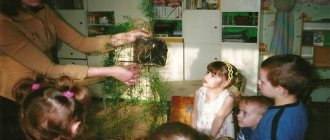Innovative environmental activities in preschool educational institutions
Practical and research activities in natural conditions play a huge role in the environmental education of preschool children. Indeed, in the process of childhood research, the child acquires specific cognitive skills: he learns to observe, reason, plan work, learns to predict the result, experiment, compare, analyze, draw conclusions and generalizations, in a word, develops cognitive abilities. Therefore, children are given an additional opportunity to get involved in research work as a leading way of understanding the world around them and cultivating the ecological consciousness of a little person.
The best discovery -
something that the child does himself.
Ralph W. Emerson, American poet and philosopher.
Preschool children are by nature inquisitive explorers of the world around them. It is this age that is most favorable for improving the functioning of the senses, accumulating ideas about the world around us, and developing the ability to see the diversity of the world in a system of relationships and interdependencies. During this period, a positive attitude towards nature, towards the “man-made world”, towards the people around you, towards yourself and your health is formed. A correct understanding of reality ensures the successful accumulation of new knowledge, rapid mastery of new activities, adaptation to any new environment, the child’s self-confidence and a high level of activity. The group created a laboratory for a young ecologist, where there is natural material collected with the help of students and parents, and there is also equipment for experiments.
The content of the educational field “Speech Development” implies familiarity with children's literature, in particular natural history. Therefore, the group has created a mini-library. It contains a variety of literature by famous children's writers, naturalists Prishvin, Bianchi, which I use in classes and thematic readings. In our free time, with the children, we learn poems about nature by our famous poets A. S. Pushkin, N. A. Nekrasov, I. A. Bunin and others.
In my work I widely use folklore. The wisdom contained in fairy tales, nursery rhymes, and riddles educates children to expressive words, teaches goodness, love for their homeland and native nature. Children love to participate in environmental performances. This helps to teach basic knowledge in a playful way.
The educational field “Artistic and Aesthetic Development” allowed the consolidated knowledge, impressions gained on walks, travel games, educational activities in kindergarten to conduct environmental holidays, entertainment, leisure, and quizzes. They help children see the uniqueness and integrity of not only a certain living organism, but also an ecosystem, realize the impossibility of violating its integrity, and understand that unreasonable interference in nature can lead to significant changes both within the ecosystem itself and beyond its borders.
Reforming preschool education in order to better satisfy the needs of parents and the interests of children places new demands on preschool educational institutions. The introduction of innovations into the work of an educational institution is the most important condition for improving and reforming the preschool education system.
Any innovation is nothing more than the creation and subsequent implementation of a fundamentally new component, as a result of which qualitative changes in the environment occur. In relation to the field of education, innovation can be considered the final result of innovative activity, embodied in the form of new content, method, form of organization of the educational process, or in a new approach to the provision of social services in the field of education based on the real requests of parents, i.e. new forms of preschool education. Do not forget that the new is considered more effective than the old if its use allows one to obtain better results in an optimal way. In general, the innovation process is understood as a complex activity of creation (birth, development), development, use and dissemination of innovations.
Technology, in turn, is a set of various techniques that are used in a particular business, craft or art. Thus, innovative technologies in preschool educational institutions are aimed at creating modern components and techniques, the main purpose of which is to modernize the educational process.
The concept of modernizing Russian education requires teachers to improve the quality of preschool education and create conditions for the personal development of each child.
Today, there are more than a hundred innovative technologies used in our kindergartens. Among them, close attention should be paid to:
- health-saving technologies;
— technologies related to project activities;
— information and communication technologies;
— personality-oriented technologies;
- gaming technologies.
Environmental education has now become one of the most important areas of preschool pedagogy, implemented in many preschool institutions in the country. Innovative technologies, so relevant in the activities of a modern preschool institution, have received new development in environmental education.
Modern innovative technologies for environmental education of preschool children: 1) health-saving technologies.
The goal of health-saving technologies in environmental education of preschool children is to ensure a high level of health, a conscious attitude towards the flora and fauna, the ability to sensory perception of the world and the emotional well-being of the child, to teach respect for one’s health and nature, to effectively solve the problems of a healthy lifestyle and safe behavior in nature, providing self-help and helping others.
Proper organization of environmental education for preschool children, optimal alternation of different health-saving technologies has a huge impact on performance, fatigue and, in general, on the functional state of the whole organism, promotes the acquisition of new knowledge, provides a practical model of correct behavior in nature, develops emotional responsiveness, and helps to gain self-confidence.
2) technologies related to project activities.
Designing educational activities is relevant at the present time. Work on projects helps to implement the principle of integration of educational areas and can be aimed at organizing gaming, cognitive-research, communicative, productive children's activities.
The specificity of the project method is that the pedagogical process is superimposed on the process of interaction of the child with the outside world, the pedagogical influence is carried out in the joint activity of an adult and children and is based on their personal experience. The goal is to work on a problem, as a result of which the child receives answers to questions.
While working on the project, children study the natural world more widely and deeply. As a result of using the project method in the environmental education of preschool children, the level of knowledge about the animal and plant world, the level of environmental literacy increases, a love for the nature of their native land is fostered, and an initiative, active and independent child is formed. It also allows you to make life in kindergarten varied and interesting.
Projects can be classified as follows:
1. “Game” – activities that are conducted in a group in the form of games, dances, and exciting entertainment.
2. “Excursion” – projects whose goal is a comprehensive and multifaceted study of the surrounding world and society.
3. “Narrative”, through which children learn to explain their feelings and emotions using speech, vocals, writing, etc.
4. “Constructive”, aimed at teaching the child to create useful objects with his own labor: build a birdhouse, plant a flower, etc.
3) information and communication technologies.
In a kindergarten setting, it is possible, necessary and advisable to use ICT in various types of educational activities, including environmental activities. The use of ICT makes it possible to make the educational process of an environmental orientation more attractive and truly modern, to solve cognitive and creative problems based on visibility. Thereby improving the quality of knowledge and skills in environmental education.
4) person-oriented technologies.
The use of personality-oriented technologies contributes to the development of a preschooler’s individuality. This is a kind of foundation for the entire educational process. The main emphasis is on the child’s personality and his specific characteristics. Depending on the child’s abilities, the teacher selects educational games that will help maximize and develop the child’s talent. There is no place for authoritarianism, imposition of opinions and an impersonal approach to the student. In the group, as a rule, there is an atmosphere of love, mutual respect and cooperation.
5) gaming technology.
Gaming technologies in kindergarten are the key to every child. In play, children learn the material better and it is easier for them to express their thoughts. They rightfully occupy an important place in the education of the younger generation.
A special place in this work is given to games with environmental content. The use of games in environmental education helps preschoolers acquire more solid knowledge and helps them master the skill of environmentally appropriate behavior in nature. The child accumulates moral and value experience in relation to the world. The types of games used in environmental education are varied in form and content and do not differ from the child’s usual play activities. This includes a theatrical game, a board game, an outdoor game, various kinds of attractions, games with natural materials, competitive games, role-playing games, didactic games, etc.
Thus, the use of innovative technologies in the field of environmental education for preschoolers allows teachers to build the process of environmental education in accordance with modern requirements and at the same time without unnecessary burden for preschoolers. The use of innovative technologies in preschool educational institutions generally leads to the fact that the child receives knowledge that is firmly fixed in his subconscious.
MAGAZINE Preschooler.RF
Innovative approaches in environmental education of preschool children.- Martynenko Svetlana Fedorovna,
- Glushchenko Anna Vasilievna,
- Gordeeva Tamara Mikhailovna,
teachers MBDOU MO kindergarten No. 228 Krasnodar
Nature is a great teacher! Environmental education is very closely related to moral education - this is the education of humanity, kindness, mercy, and a responsible attitude towards nature and the people who live nearby. During preschool childhood, the child undergoes intensive social development, which is carried out through his interaction with others, peers and adults. The period of formation of the foundations of a future personality is preschool age.
Our task is to teach the child to treat every living organism as a valuable, unique entity that has the right to life. The best result can be achieved if you begin to form the foundations of environmental culture in preschool age
The problem of the relationship between man and nature is not new; it has always existed. But now, at the present time, the environmental problem of interaction between man and nature, as well as the interaction of human society on the environment, has become very acute and has assumed enormous proportions.
At the present stage, issues of traditional interaction between nature and man have grown into a global environmental problem. If people do not learn to take care of nature in the near future, they will destroy themselves. And in order to prevent this from happening, it is necessary to cultivate an environmental culture and responsibility. And it is necessary to begin environmental education from preschool age, since it is at the stage of preschool childhood that the child receives emotional impressions of nature, accumulates ideas about different forms of life, that is, the fundamental principles of ecological thinking and consciousness are formed in him, and the initial elements of ecological culture are laid.
Innovative technologies have received their new development in environmental education, since the nature of environmental knowledge determines not only various forms of border integration of related subjects, but also the integration of various areas of education and training of preschool children.
Environmental education of preschool children can be carried out in different educational areas. Thus, the content of the educational field “Socio-communicative development” is aimed at mastering the norms and values accepted in society; development of emotional responsiveness, empathy, including in relation to natural objects. The content of the educational field “Cognition” is aimed at the formation of primary ideas about the objects of the surrounding world, their properties and relationships (color, shape, size, causes and effects, etc.). The content of the educational field “Speech Development” implies familiarity with children's literature, in particular natural history. The educational field “Artistic and Aesthetic Development” implies the formation of the foundations of value-semantic perception and understanding of the world around us. The educational field “Physical Development” is aimed at developing the values of a healthy lifestyle in children.
New types and forms of environmental education for preschoolers - didactic environmental games. Game is one of the types of human activity that is the leader in childhood. The value of the game cannot be limited to just entertainment opportunities. A didactic game is an active form of learning in which two principles operate simultaneously: educational and entertaining.
The didactic game is designed to soften the transition from one activity to another, to make the process of acquiring knowledge and ideas about the world easier. One of the forms of environmental education and upbringing in preschool educational institutions is environmental actions - this is a set of events and actions that helps children better understand a certain environmental problem, show their civic position, and express their attitude towards something.
Such events help consolidate knowledge about natural phenomena, teach children to independently plan their activities, and develop independence and responsibility in children.
Using new technologies in an interesting, entertaining way, it helps children see all the beauty of nature, reveal all its secrets and laws, and instills in children kindness and a responsible attitude towards the world around them and the people who live nearby.
Literature:
- Anokhin E.V., Bondarenko T.M., Sukhanova A.S., Bondarenko T.M. Environmental activities with children 6–7 years old. - Voronezh: Lakotsenin, 2007.
- Kondratyeva T.N., Kurochkina S.N. Environmental education of children of senior preschool age in the process of environmental actions // Problems of the formation of environmental thinking in modern society, materials of the International Scientific and Practical Internet Conference. — 2014.
- Pavlova L. Yu. Didactic games as a means of ecological and aesthetic education of children 5–7 years old: Dis. Ph.D. ped. Sci. - M., 2002.
| Next > |
Innovative project for environmental education of preschool children “Pathway to the wonderful world of nature”
Visibility.
The principle allows us to take into account the visual-figurative and visual-effective thinking of a preschool child. The use of this principle assumes that in order to solve the goals and objectives of environmental education, the teacher selects objects and processes that are accessible to understanding and mastery by a child of a certain age, which he can observe directly in his environment. The principle of visibility also means the constant use of visual material when working with children: illustrations, manuals, video materials, paintings, posters, models, layouts, etc.
Humanity.
This principle is associated primarily with the concept of ecological culture. From the perspective of education, its use means the formation of a person with new values, who knows the basics of consumer culture, cares about his health and wants to lead a healthy lifestyle. Ultimately, the goal of environmental education is to preserve human health in a healthy, environmentally friendly environment.
Predictiveness.
For preschoolers, this principle means that as a result of environmental education, children form elementary ideas about the relationships existing in nature and, based on these ideas, the ability to predict their actions in relation to the environment during rest, work in nature and living conditions (elements of rational use resources). Compared to school, in preschool education, due to the age characteristics of the child, prognostication is limited to instilling in children the habit and ability to evaluate some everyday actions in relation to the environment, and to restrain their desires if they can harm nature. There is no need to instill in a child a “sense of responsibility for the state of the entire planet” (or the environment, as is often suggested!). It is enough that the child will take care of the guinea pig, feed the birds and grow plants.
Activities.
Ecological knowledge should help the child understand what needs to be done in order to preserve the environment around him and his loved ones. He must necessarily take part in feasible environmentally oriented activities. In addition, in the process of such activity, the formation and formation of the “child - environment” relationship occurs. The principle of activity underlies various environmental projects, in which children of middle and senior preschool age can take part.
Integrations.
Currently, this principle is increasingly being implemented in preschool environmental education. The importance of its application is due to several reasons: firstly, the integrated nature of environmental knowledge as such; secondly, consideration of environmental education from the point of view of the comprehensive development of the child’s personality and, thirdly, the peculiarities of the organization and methodology of all work in a preschool institution. The latter makes the implementation of the principle of integration in preschool institutions a more realistic task than in school. At the preschool level, this is reflected in the need to green the entire activity of the teaching staff and green the various types of activities of the child.









